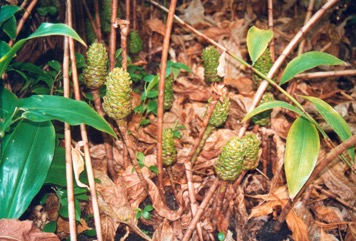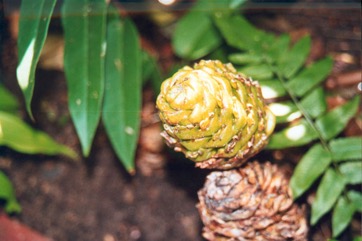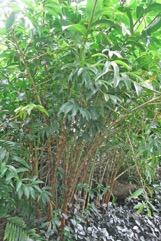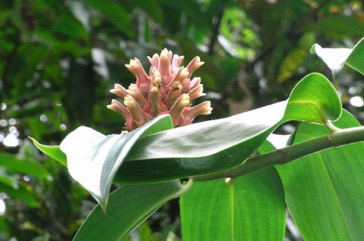Crepe Ginger

It is a tropical plant. It does best in humus-rich, moist, soils. It prefers a sheltered, shady position. It is drought and frost tender. They need a minimum temperature above 18°C. In Nepal is grows between 400-700 m altitude. It suits hardiness zones 9-12. In Cairns Botanical Gardens. In Adelaide Botanical Gardens hot house. In Yunnan.
Also known as:
'uangz, Bai-qiekepa, Besemati, Besika dumpa, Betlauri, Bi qiao jiang, Buritokon, Cane-reed spiralflag, Cat loi, Chengalvakoshtu, Dot dang, Halduli, I-upo, Kemuka, Ken, Kenkemuka, Keon, Keu, Keukand, Keula, Keun, Kevkanda, Kewkanda, Koekand, Kuiravam, Larkaiya, Malay ginger, Maqbaomagaoqyyuq, Mia do, Ngueng maai na, Nuoyingdao, Orop, Ote kitamuli ba, Pacing, Penva, Pewda, Pha-lan-taung-hwa, Pushakara moola, Pushkarmula, Ru-rta, Setawar, Setengteng, Spiral Ginger, Tabar-tabar, Tar thok, Tawar, Tebu, Tiuasi, Tongro, Trathok, Tubong-usa, Uang-din, Uang-maina, Uang-phetma, Uang-yai, Ueang-phet-maa, Unnithandu, Urubkutub, Zhang liu tou
Synonyms
- Amomum arboreum Lour.
- Amomum hirsutum Lamk.
- Banksia speciosa Koenig
- Costus loureiri Horan.
- Costus formosanus Nakai
- Costus nepalensis Roscea
- Costus sericeus Blume
- Costus speciosus (Koenig) Sm.
- and many others
Edible Portion
- Leaves, Rhizome, Corm, Root, Fruit, Flower bud, Seed
Where does Crepe Ginger grow?
Found in: Asia, Australia, Bhutan, Cambodia, Central America, China, Costa Rica, Fiji, Hawaii, Himalayas, India, Indochina, Indonesia, Laos, Malaysia, Marquesas, Myanmar, Nepal, Nicaragua, Northeastern India, Pacific, Papua New Guinea, PNG, Philippines, Samoa, SE Asia, Sri Lanka, Taiwan, Thailand, United States, Vietnam, West Indies
Notes: It is used as a medicine in Indonesia and China. There are 250 Costus species. They are tropical.
Growing Crepe Ginger
Cultivation: It is grown by seed or by division of the clump.
Edible Uses: The tuberous roots are cooked and eaten. This is normally only when food is scarce. They are sliced and cooked with other vegetables in curries. The young shoots are eaten in soup dishes. The stems are peeled and eaten. The young leaves can be stored for 7-8 days. CAUTION: The roots contain diosgenin a precursor of steroids and hormones for contraceptives.
Nutrition Info
per 100g edible portion| Edible Part | Energy (kcal) | Protein (g) | Iron (mg) | Vitamin A (ug) | Vitamin c (mg) | Zinc (mg) | % Water |
|---|---|---|---|---|---|---|---|
| - | - | - | - | - | - |
Crepe Ginger Photos




References
Acharya K. P. and Acharya, R., 2010, Eating from the Wild: Indigenous knowledge on wild edible plants in Parroha VDC of Rupandehi District, Central Nepal. International Journal of Social Forestry. 3(1):28-48 (As Cheilocostus speciosus)
Altschul, S.V.R., 1973, Drugs and Foods from Little-known Plants. Notes in Harvard University Herbaria. Harvard Univ. Press. Massachusetts. no. 458 (As Costus speciosus)
Ambasta, S.P. (Ed.), 2000, The Useful Plants of India. CSIR India. p 143 As Costus speciosus)
Anderson, E. F., 1993, Plants and people of the Golden Triangle. Dioscorides Press. p 207 (As Costus speciosus)
Bandyopadhyay, S., et al, 2012, A Census of Wild Edible Plants from Howrah District, West Bengal, India. Proceedings of UGC sponsored National Seminar 2012 (As Costus speciosus)
Baro, D., Baruah, S. and Borthukar, S. K. 2015, Documentation on wild vegetables of Baksa district, BTAD (Assam). Scholars Research Library. Archives of Applied Science Research, 2015, 7 (9):19-27 (As Costus speciosus)
Bodkin, F., 1991, Encyclopedia Botanica. Cornstalk publishing, p 289 (As Costus speciosus)
Bohra, N., et al, 2017, Ethnobotany of wild edible plants traditionally used by the local people in the Ramnagar regions from Nainital District, Uttarakhand, India. Biolife 5(1): 12-19 (As Costus speciosus)
Borrell, O.W., 1989, An Annotated Checklist of the Flora of Kairiru Island, New Guinea. Marcellin College, Victoria Australia. p 42 (As Costus speciosus)
Brickell, C. (Ed.), 1999, The Royal Horticultural Society A-Z Encyclopedia of Garden Plants. Convent Garden Books. p 306 (As Costus speciosus)
Brown, D., 2002, The Royal Horticultural Society encyclopedia of Herbs and their uses. DK Books. p 181 (As Costus speciosus)
Burkill, I.H., 1966, A Dictionary of the Economic Products of the Malay Peninsula. Ministry of Agriculture and Cooperatives, Kuala Lumpur, Malaysia. Vol 1 (A-H) p 681 (As Costus speciosus)
Cao, Y., et al, 2020, Ethnobotanical study on wild edible plants used by three trans-boundary ethnic groups in Jiangcheng County, Pu’er, Southwest China. Journal of Ethnobiology and Ethnomedicine (2020) 16:66 (As Cheilocostus speciosus)
Chandrakumar, P., et al, 2015, Ethnobotanical studies of wild edible plants of Gond, Halba and Kawar tribes of Salekasa Taluka, Gondia District, Maharashtra State, India. International Research Journal of Pharmacy 6(8) (As Costus speciosus)
Chen, I., et al, 2008, Antioxidant and Antimicrobial Activities of Zingiberaceae Plants in Taiwan. Plant Foods for Human Nutritition, 63:15-20 (As Costus speciosus)
Dangol, D. R., 2002, Economic uses of forest plant resources in western Chitwan, Nepal. Banko Janakari, 12(2): 56-64 (As Costus speciosus)
Dey, A. & Mukhererjee, A., 2015, Living and Survival Amidst Hunger: Wild Edible Botanicals as a Prime Forest Productivity in the Rural Purulia District, West Bengal, India from Colonial to Present. Research Journal of Forestry 9(3): 71-86 (As Costus speciosus)
Dhyani, S.K., & Sharma, R.V., 1987, Exploration of Socio-economic plant resources of Vyasi Valley in Tehri Garwhal. J. Econ. Tax. Bot. Vol. 9 No. 2 pp 299-310 (As Costus speciosus)
Dobriyal, M. J. R. & Dobriyal, R., 2014, Non Wood Forest Produce an Option for Ethnic Food and Nutritional Security in India. Int. J. of Usuf. Mngt. 15(1):17-37 (As Costus speciosus)
Dutta, U., 2012, Wild Vegetables collected by the local communities from the Churang reserve of BTD, Assam. International Journal of Science and Advanced Technology. Vol. 2(4) p 120 (As Costus speciosus)
Eiadthong, W., et al, 2010, Management of the Emerald Triangle Protected Forests Complex. Botanical Consultant Technical Report. p 23 (As Costus speciosus)
Elliot, W.R., & Jones, D.L., 1984, Encyclopedia of Australian Plants suitable for cultivation. Vol 3. Lothian. p 103 (As Costus speciosus)
Engel, D.H., & Phummai, S., 2000, A Field Guide to Tropical Plants of Asia. Timber Press. p 229 (As Costus speciosus)
Facciola, S., 1998, Cornucopia 2: a Source Book of Edible Plants. Kampong Publications, p 83 (As Costus speciosus)
Hani Medicine of Xishuangbanna, 1999, p 423(As Costus speciosus)
Hedrick, U.P., 1919, (Ed.), Sturtevant's edible plants of the world. p 222 (As Costus speciosus)
Hibbert, M., 2002, The Aussie Plant Finder 2002, Florilegium. p 75 (As Costus speciosus)
Hill, M. & Hallam, D., (eds), 1997, Na Hang Nature Reserve, Tat Ke Sector. Site description and conservation evaluation. Hanoi. p 76 (As Costus speciosus)
Hoare, A., 2003, Food use of the Lundayeh SW Sabah. Borneo Research Council. (As Costus speciosus)
Hoe, V. B. & Siong, K. H., 1999, The nutritional value of indigenous fruit and vegetables in Sarawak. Asia Pacific J. Clin. Nutr. 8(1):24-31 (As Costa speciosus - Sempulang padi)
http://www.ntbg.org/plants/plant details.php (As Costus speciosus)
Hu, Shiu-ying, 2005, Food Plants of China. The Chinese University Press. p 327 (As Costus speciosus)
Jones D, L, 1986, Ornamental Rainforest Plants in Australia, Reed Books, p 267 (As Costus speciosus)
Joshi, N., et al, 2007, Traditional neglected vegetables of Nepal: Their sustainable utilization for meeting human needs. Tropentag 2007. Conference on International Agricultural Research for Development. (As Costus speciosus)
Kachenchart, B., et al, 2008, Phenology of Edible Plants at Sakaerat Forest. In Proceedings of the FORTROP II: Tropical Forestry Change in a Changing World. Bangkok, Thailand. (As Costus speciosus)
Kermath, B. M., et al, 2014, Food Plants in the Americas: A survey of the domesticated, cultivated and wild plants used for Human food in North, Central and South America and the Caribbean. On line draft. p 268 (As Costus speciosus)
Khumgratok, S., Edible Plants in Cultural Forests of Northeastern Thailand. Mahasarakham University Thailand. (As Costus speciosus)
Kumar, G.M., & Shiddamallayya, N., 2014, Documentation of Wild Plant Tubers as Food Resources in Hassan District, Karnataka, International Journal of Applied Biology and Pharmaceutical Technology. 5(2) p 90 (As Costus speciosus)
Kuvar, S. D. & Shinde, R. D., 2019, Wild Edible Plants used by Kokni Tribe of Nasik District, Maharashtra. Journal of Global Biosciences. Volume 8, Number 2, 2019, pp. 5936-5945 (As Cheilocostus speciosus)
Leach, G. J., 1988, Bush Food Plants of the Blackwater and Karawari Rivers Area, East Sepik Province, Papua New Guinea. Science in New Guinea 14(2). p 101 (As Costus speciosus)
Lim, T. K., 2015, Edible Medicinal and Non Medicinal Plants. Volume 9, Modified Stems, Roots, Bulbs. Springer p 28 (As Cheilocostus speciosus)
Llamas, K.A., 2003, Tropical Flowering Plants. Timber Press. p 364 (As Costus speciosus)
Macmillan, H.F. (Revised Barlow, H.S., et al), 1991, Tropical Planting and Gardening. Sixth edition. Malayan Nature Society. Kuala Lumpur. p 356 (As Costus speciosus)
Manandhar, N.P., 2002, Plants and People of Nepal. Timber Press. Portland, Oregon. p 172 (As Costus speciosus)
Martin, F.W. & Ruberte, R.M., 1979, Edible Leaves of the Tropics. Antillian College Press, Mayaguez, Puerto Rico. p 225 (As Costus speciosus)
Mishra, M., 2013, Utilization of wild tuberous plants in extreme environmental condition: A Case of Baiga Tribe of Central India. The Journal of Ethnobiology and Traditional Medicine. Photon 118 (2013) 366-372 (As Costus speciosus)
Misra, R. C., et al, 2013, Genetic resources of wild tuberous food plants traditionally used in Similipal Biosphere Reserve, Odisha, India. Genetic Resources and Crop Evolution. Vol. 60 No. 2. Springer (As Costus speciosus)
Mot So Rau Dai an Duoc O Vietnam. Wild edible Vegetables. Ha Noi 1994, p 72 (As Costus speciosus)
Narayanan Ratheesh, M. K. et al, 2011, Wild edible plants used by the Kattunaikka, Paniya and Kuruma tribes of Wayanad District, Kerala, India. Journal of Medicinal Plants Research Vol. 5(15), pp. 3520-3529 (As Costus speciosus)
Narzary, H., et al, 2013, Wild Edible Vegetables Consumed by Bodo tribe of Kokrajhar District (Assam), North-East India. Archives of Applied Science Research, 5(5): 182-190 (As Costus speciosus)
Ogle, B. M., et al, 2003, Food, Feed or Medicine: The Multiple Functions of Edible Wild Plants in Vietnam. Economic Botany 57(1): 103-117 (As Costus speciosus)
Pandy, R. K. & Saini, S. K., 2007, Edible plants of tropical forests among tribal communities of Madhya Pradesh. Indian Journal of Traditional Knowledge. 6(1), pp 185-190 (As Costus speciosus)
Prafulla, S., 2017, Wild Food Diversity of Nawegaon-Nagzira Tiger Reserve in Gondia-Bhandara district of Maharashtra, India. Int. J. of Life Sciences, 2017, Vol. 5 (4): 620-626 (As Costus speciosus)
Peekel, P.G., 1984, (Translation E.E.Henty), Flora of the Bismarck Archipelago for Naturalists, Division of Botany, Lae, PNG. p 109, 110 (As Costus speciosus)
Pegu, R., et al, 2013, Ethnobotanical study of Wild Edible Plants in Poba Reserved Forest, Assam, India. Research Journal of Agriculture and Forestry Sciences 1(3):1-10 (As Costus speciosus)
Phon, P., 2000, Plants used in Cambodia. © Pauline Dy Phon, Phnom Penh, Cambodia. p 175 (As Costus speciosus)
PROSEA handbook Volume 9 Plants yielding non-seed carbohydrates. p 170 (As Costus speciosus)
Rahangdale, D.R. & Rahangdale, S.S., 2014, Potential Wild Edible Plant Resources from Maharashtra Future Prospects for their Conservation and Improvement. Life Science Leaflets. http://lifesciencesleaflets.ning.com (As Costus speciosa)
Rao, M. L. S., et al, 2014, Indigenous Plant Foods which are commonly consumed by the tribal communities in Dumbriguda Area of Visakhapatnam District, Andhra Pradesh, India. Biolife. Vol 2, Issue 3 (As Costus speciosus)
Recher, P, 2001, Fruit Spirit Botanical Gardens Plant Index. www.nrg.com.au/~recher/ seedlist.html p 4 (As Costus speciosus)
Samy, J., Sugumaran, M., Lee, K. L. W., 2009, Herbs of Malaysia, Marshall Cavendish. p 84 (As Costus speciosus)
Samydurai, P., et al, 2012, Wild habits of Kolli Hills being staple food of inhabitant tribes of eastern Ghats, Tamil Nadu, India. Indian Journal of Natural Products and Resources. 3(3) September 2012 pp 432-437 (As Costus speciosus)
Sarma, H., et al, 2010, Updated Estimates of Wild Edible and Threatened Plants of Assam: A Meta-analysis. International Journal of Botany 6(4): 414-423 (As Costus speciosus)
Seidemann J., 2005, World Spice Plants. Economic Usage, Botany, Taxonomy. Springer. p 118 (As Costus speciosus)
Setiya, A. V., et al, 2016, Exploration and documentation of some wild edible plants used by the aboriginals from Gadchiroli District (M.S.) India. International Advanced Research Journal in Science, Engineering and Technology. 3(7) (As Cheilocostus speciosus)
Singh, H.B., Arora R.K.,1978, Wild edible Plants of India. Indian Council of Agricultural Research, New Delhi. p 12 (As Costus speciosus)
Slik, F., www.asianplant.net (As Cheilocostus speciosus)
Smith, A.C., 1979, Flora Vitiensis Nova, Lawaii, Kuai, Hawaii, Volume 1 p 191 (As Costus speciosus)
Smith, N., Mori, S.A., et al, 2004, Flowering Plants of the Neotropics. Princeton. p 430 (As Costus speciosus)
Staples, G.W. and Herbst, D.R., 2005, A tropical Garden Flora. Bishop Museum Press, Honolulu, Hawaii. p 652 (Drawing) (As Costus speciosus)
Sukarya, D. G., (Ed.) 2013, 3,500 Plant Species of the Botanic Gardens of Indonesia. LIPI p 1088 (As Cheilocostus speciosus)
Suksri, S., et al, 2005, Ethnobotany in Bung Khong Long Non-Hunting Area, Northeast Thailand. Kasetsart J., (Nat. Sci) 39: 519-533 (As Costus speciosus)
Tanaka, Y. & Van Ke, N., 2007, Edible Wild Plants of Vietnam: The bountiful garden. Orchid books. p 69 (As Costus speciosus)
Teron, R. & Borthakur, S. K., 2016, Edible Medicines: An Exploration of Medicinal Plants in Dietary Practices of Karbi Tribal Population of Assam, Northeast India. In Mondal, N. & Sen, J.(Ed.) Nutrition and Health among tribal populations of India. p 157 (As Costus speciosus)
Tewari, D.N., 1994, Important Plants of India. International Book Distributors, India. p 112 (As Costus speciosus)
Trans. Linn. Soc. London 1:249. 1791 (As Costus speciosus)
Turreira Garcia, N., et al, 2017, Ethnobotanical knowledgeof the Kuy and Khmer people in Prey Lang, Cambodia. Cambodian Journal of Natural History 2017 (1): 76-101 (As Costus speciosus)
Van Sam, H. et al, 2008, Uses and Conservation of Plant Species in a National Park. A case study of Ben En, Vietnam. Economic Botany 62:574-593 (As Costus speciosus)
Whitney, C. W., et al, 2014, Conservation and Ethnobotanical Knowledge of a Hmong Community in Long Lan, Luang Prabang, Lao People’s Democratic Republic. Ethnobotany Research and Applications 12:643-658
Wijayakusuma, H.M.H., et al, 1996, Tanaman Berkhasiat Obat Di Indonesia. Pustaka Kartini. p 101 (As Costus speciosus)
World Checklist of Useful Plant Species 2020. Royal Botanic Gardens, Kew (As Hellenia speciosa)
Wu Delin; Kai Larsen, Flora of China COSTACEAE (As Costus speciosus)
Xu, Z., Tao, G. & Tan, J., 1988, Tropical Wild Flowers and Plants in Xishuangbanna, Agricultural Publishing House. photo 57 (As Costus speciosus)
Xu, You-Kai, et al, 2004, Wild Vegetable Resources and Market Survey in Xishuangbanna, Southwest China. Economic Botany. 58(4): 647-667. (As Costus speciosus)